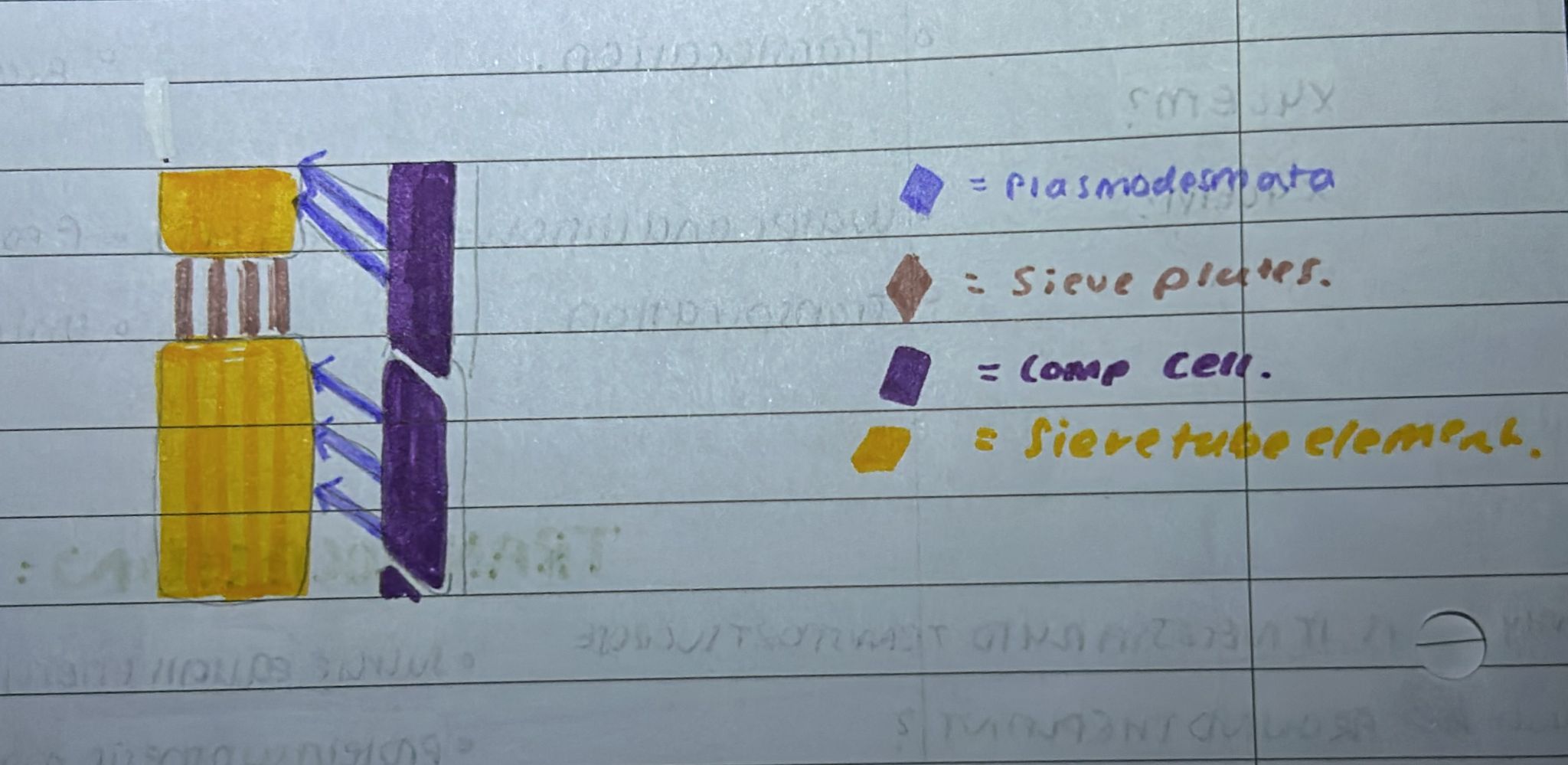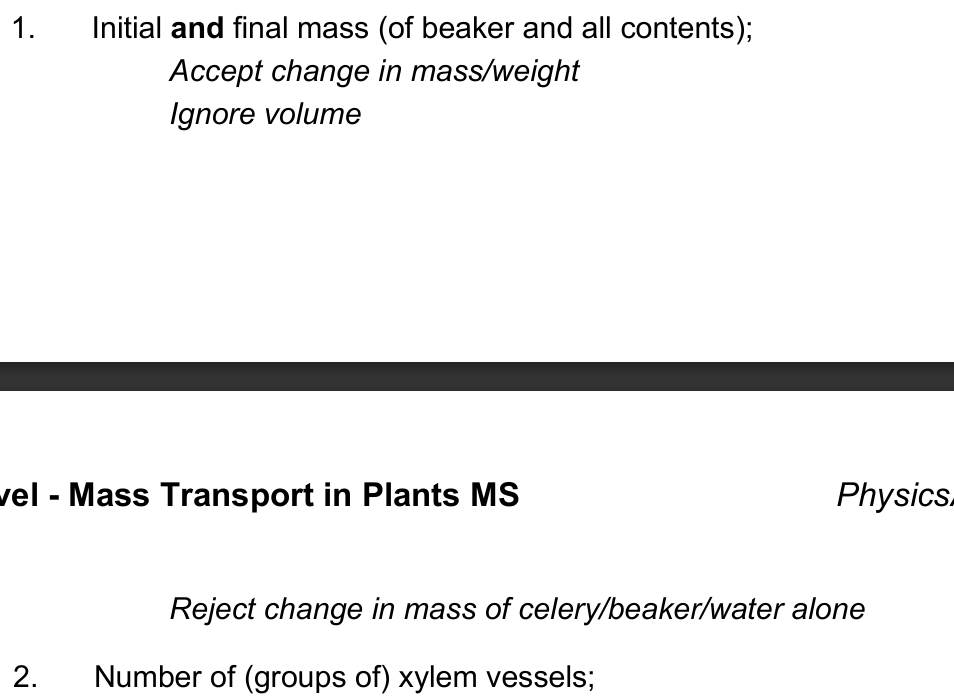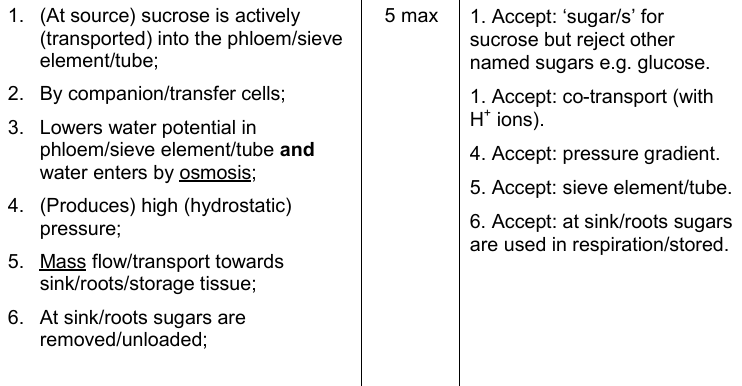3.4 MT - PLANTS
1/24
There's no tags or description
Looks like no tags are added yet.
Name | Mastery | Learn | Test | Matching | Spaced |
|---|
No study sessions yet.
25 Terms
DESCRIBE THE COHESION-TENSION THEORY OF WATER TRANSPORT IN THE XYLEM?
Water loss by transpiration from the leaf through the stomata.
This ψ of the mesophyll/leaf cells.
Water is pulled UP the xylem, creating tension.
Water molecules cohere together by H bonds.
Forming a continuous water column.
Adhesion of water molecules to walls of xylem.
WHAT IS MASS TRANSPORT?
Movement of materials over large distances.
Due to pressure differences.
WHAT DOES THE PHLOEM TRANSPORT?
FROM WHERE TO WEAR?
HOW MANY DIRECTIONS?
Transports organic substances.
From leaves to other parts of plants.
Bidirectional.
WHAT DOES THE XYLEM TRANSPORT?
FROM WHERE TO WEAR?
HOW MANY DIRECTIONS?
Water and dissolved minerals.
From soil, to roots, to stem and leaves.
Unidirectional.
WHY IS IT NECASSARY TO TRANSPORT SUCROSE AND AMINO ACIDS AROUND THE PLANT?
Sucrose = energy source.
Amino Acids = protein synthesis.
Only leaves produce them, but the entire plant needs them.
WHY ARE REDUCING SUGARS TRANSPORTED IN THE PHLOEM?
Reducing are too reactive and would be chemically altered before arriving at their destination.
WHAT IS THE PHLOEM TISSUE MADE OF?
Sieve tube elements (long thin cells arranged end to end).
Companion cells are associated with sieve tubes.
STRUCTURE OF THE SIEVE TUBES?
Each sieve tube element links to the next via a sieve plate which is perforated with pores.
The sieve tube has little cytoplasm, no nucleus, no vacuole, and few organelles, other than some mitochondria.
The sieve tubes are alive because of plasmodesmata (cytoplasmic connections) with the cytoplasm.
STRUCTURE OF THE COMPANION CELLS?
DIAGRAM?
Many mitochondria.

USE MASS FLOW HYPOTHESIS TO EXPLAIN HOW PRESSURE IS GENERATED IN PHLOEM?

EVIDENCE FOR MASS FLOW?
High hydrostatic pressure in the phloem, shown by sap release when cut.
Higher [sucrose] in leaves over roots.
Downward flow in phloem only.
[Sucrose] in leaves followed by [] in phloem later.
Metabolic inhibitors and/or lack of oxygen inhibit translocation of sucrose.
Companion cells have many mitochondria.
Ringing experiment.
Radioactive tracer experiments.
WHAT IS THE RINGING/GIRDLING EXPERIMENT?
MASON AND MASKEL (1928)
Remove ring of bark, removes phloem only.
Bark below it dies.
Back above it swells and remains healthy.
WHAT IS THE RADIOACTIVE TRACER EXPERIMENT?
If a plant is exposed to 14CO2 it will produce radioactive carbohydrates.
Autoradiography:
Cut thin tissue sections of different areas of the plant.
Place photographic film on them,
Film will blacken where exposed to 14CO2 .
Occurs almost entirely only to sieve elements and companion cells.
EVIDENCE AGAINST MASS FLOW?
Mass flow should move all solutes at the same speed.
Mass flow doesn’t state function of sieve plates as they would hinder mass flow of sucrose - they could precent sieve tubes from bursting under pressure.
Sucrose is delivered mostly at the same rate to all sinks, rather than going faster to those with lower (sucrose) as mass flow would suggest.
WHAT IS TRANSPIRATION?
Consequence of gas exchange in the leaves.
Water movement through plant and its evaporation from leaves.
MOVEMENT OF WATER THROUGH THE LEAF?
When the stomata are open, water vapour diffuses from the air spaces in the leaf, out through the stomata, down a ψ gradient —> this is transpiration.
To replace this, water evaporates from the walls of the mesophyll cells into air spaces, forming water vapour, which builds up in the air spaces.
Water in the mesophyll cells is replaced by water from the xylem cells.
WHAT IS XYLEM TISSUE?
Series of continuous tubes called xylem vessels.
WHAT ARE XYLEM VESSELS?
Modified dead cells, arranged end-to-end.
STRUCTURAL FEATURES OF XYLEM VESSELS AND THEIR FUNCTIONS?
Lignin in cell walls:
Strengthens + waterproof.
Causes cell contents to die, creating hollow lumen (no cytoplasm) to gave little resistance to mass flow.
Pits in walls:
Allows water to be diverted laterally in cases of damage, so it can continue flowing in adjacent vessels.
No end walls:
Forms a continuous column of water from root to leaves.
Thickening of cell wall is SPIRAL:
Uses less material ::: less wasteful.
Allows for flexibility.
Lower mass.
COHESIN TENSION THEORY IN SHORT?
Evaporation of water from the leaves pulls up more water from xylem to stem.
EVIDENCE FOR COHESION-TENSION THEORY?
Tension has been measured in the xylem as plants transpire.
If a column of water in the xylem is broken, air bubbles in the xylem form and this stops any further upwards movement of water in the xylem vessel as the air bubbles prevent cohesion.
Respiratory inhibitors don’t inhibit.
Diameter of trees decrease when they transpire (tension pulls xylem walls in) and more so when temperature and light intensity are increased.
Can be measured using a dendrometer.
When xylem vessel is broken, water doesn’t leak out, air is drawn in.
FACTORS AFFECTING TRANSPIRATION?
FACTORS INCREASING IT:
[Light].
Windspeed.
Temperature.
FACTORS DECREASING IT:
Humidity,
FEATURES OF XEROPHYTIC PLANTS?
Rolled leaves.
Waxy waterproof cuticle, thick.
Close stomata.
Hairs.
Stomata sunken in pits.
Reduce SA:V of leaves —> slower diffusion.
Stomata on underside of lead onlu.
Daylight closure of stomata.
Succulent stems or leaves to store water.
MEASUREMENTS NEEDED TO MEASURE RATE OF WATER MOVEMENT IN A PLANT?
Time taken for water movement.

DESCRIBE THE PROCESSES INVOLVED IN THE TRANSPORT OF SUGARS IN PLANT STEMS?
4.5 Increase in pressure causes the mass flow.
6.Unloading by AT.
